Wheelwright facts for kids
A wheelwright was a skilled person who built or fixed wheels, especially wooden ones. Long ago, when people used many carts and wagons, the wheelwright had a very important job. While a cartwright built the cart itself, the wheelwright was the expert who specialized in making the strong, round wheels.
The word "wheelwright" isn't used much today. Modern wheels are made in large factories using machines. Many different people work together on a production line, each doing a small part of the process.
Contents
Wheelwrights: Masters of the Wheel
In the past, making a wooden wheel was a complex task. It needed a lot of skill and knowledge. Wheelwrights had to choose the right wood, shape it perfectly, and then fit all the pieces together tightly.
How Wooden Wheels Were Made
Wooden wheels were not just one solid piece of wood. They were made from several parts:
- The hub was the center part that connected to the axle of the cart.
- The spokes were the pieces of wood that went from the hub to the outer rim.
- The felloes (pronounced FELL-ohs) were curved sections of wood that formed the outer rim of the wheel. Several felloes were joined together to make a full circle.
Once the wooden parts were assembled, a metal band called a tire was often fitted around the felloes. This metal tire protected the wood and made the wheel stronger and more durable. Sometimes, instead of one continuous tire, several smaller metal strips called strakes were hammered onto the felloes.
From Handcraft to Factory
For hundreds of years, wheelwrights were essential to transportation. They built wheels for everything from farm carts to carriages. Each wheel was handcrafted, making it unique.
Today, most wheels for cars, bicycles, and other vehicles are made from metal, rubber, or other materials in large factories. This change means that the traditional wheelwright's craft is now very rare. Only a few people still practice this ancient skill, often for historical restoration or special projects.
Images for kids
-
This plate published in a volume of Encyclopédie in 1769 shows both methods of shoeing a wheel. In the centre the labourers are using hammers and "devil's claws" to fit a hoop onto the felloe, and on the right they're hammering strakes into place.




